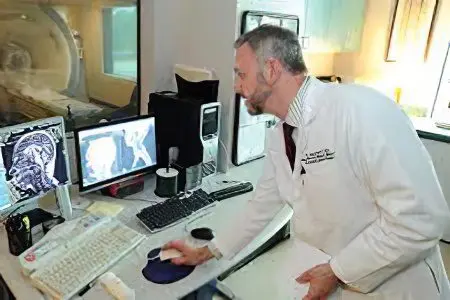Contents

The basis of this neurological pathology is an excessive accumulation of cerebrospinal fluid (CSF) in various parts of the brain. Hydrocephalus in adults is often diagnosed as a complication of traumatic brain injury, a consequence of a brain tumor, stroke, neuroinfection, meningitis. In addition, hydrocephalus can be congenital or develop as a result of age-related changes.
The clinical picture of the disease depends on the causes of its occurrence and the form that the pathology takes:
Hypersecretory hydrocephalus – the basis of the pathology is a violation of the production of cerebrospinal fluid, leading to the expansion of the ventricles;
Disresorptive and aresorptive hydrocephalus – the cause is a violation of the absorption of cerebrospinal fluid;
Proximal and distal form of occlusive hydrocephalus – the cause of the development of the disease is a violation of the circulation of cerebrospinal fluid.
The treatment of hydrocephalus of the adult brain is carried out by specialists practicing in such fields of medicine as neurology and neurosurgery. More recently, it has traditionally been considered that hydrocephalus is a problem in the field of pediatrics, because it is most often diagnosed as a congenital pathology. According to medical statistics, for a thousand infants aged 1 month, there are from one to ten newborns with a similar diagnosis.
To date, very little attention has been paid to the diagnosis and treatment of the pathology of the same name in adults, if we do not take into account the activities of specialized clinics and hospitals. That is why until today there are no certain standards for diagnosing hydrocephalus in adults, although in most cases the results of echoencephalography and rheoencephalography would be sufficient for making a diagnosis.
The consequence of incorrect diagnosis is the treatment of hydrocephalus after injuries and strokes, as diseases and conditions with similar symptoms:
Psychoorganic symptom;
Dementia of mixed origin;
Consequences of a stroke, brain injury;
Post-traumatic and discirculatory encephalopathy.
Patients with hydrocephalus are treated for a long time in psychiatric clinics and neurological hospitals with a negative result and minimal dynamics, although a correctly conducted examination in a specialized department reveals hydrocephalic syndrome in 25% of adult patients.
These people can be helped to return to work, avoid disability, be given the opportunity to serve themselves without outside help. Almost 100% of adult patients suffering from hydrocephalus, after surgical treatment, are able to achieve recovery.
Modern methods of emergency surgical care, carried out in the first two days, will help to avoid a negative outcome of the disease as a result of an acute form of hydrocephalus caused by subarachnoid hemorrhage. Shunting and injection of thrombolytics into brain structures stabilize the patient’s condition and give a chance for a full recovery.
Causes of hydrocephalus

Hydrocephalus can be the result of many neurological pathologies, disorders of the central nervous system.
Common causes of the disease:
Acute disorders of cerebral circulation, as a result of hemorrhagic or ischemic stroke;
Encephalopathy resulting from trauma, alcoholism, hypoxia, toxic damage;
Malignant tumors localized inside the ventricles, in the brain stem;
Neuroinfections, inflammatory diseases of the central nervous system (tuberculosis, encephalitis, meningitis, ventriculitis);
Rupture of an aneurysm or arteriovenous vessels of the brain;
Traumatic injury causing intraventricular and subarachnoid bleeding.
Classification of hydrocephalus in adults
Base | Type of hydrocephalus |
By pathogenesis |
|
According to the level of liquor pressure |
|
By the pace of the flow |
|
Adult hydrocephalus is an acquired form of the disease. On such a basis as pathogenesis, it is divided into 3 types. A few years ago, the classification list included mixed external hydrocephalus, which occurs with progressive brain atrophy due to ventricular hypertrophy.
At the moment, this item is removed from the classification, since its cause is not a violation of the circulation of the cerebrospinal fluid, but a decrease in the mass of brain tissues, their atrophy.
Symptoms of hydrocephalus of the brain
There are acute and chronic forms of the disease.
Acute symptoms

Symptoms of the acute form of occlusive hydrocephalus manifest themselves as signs of increased intracranial pressure:
Headache – most acutely manifested in the first half of the day, since intracranial pressure often increases during night sleep;
Nausea and vomiting – most often noted in the morning, often after vomiting the patient feels a decrease in the intensity of the pain syndrome;
Drowsiness – a negative symptom of intracranial pressure, indicates the approach of deterioration.
Axial dislocation of the brain – Another manifestation of hydrocephalus. As a result of dislocation, the brain tissues are displaced in relation to its solid substances. In this case, the space inside the cranium is divided and limited. In this condition, the brain is displaced along an axis passing through a large opening in the back of the head and through the opening of the cerebellum tenon.
Dislocation symptoms:
Convulsions;
Reduced vision (may be persistent or transient), oculomotor disorders are diagnosed;
Severe headaches;
Nausea and repeated vomiting;
Rapid depression of consciousness, leading to coma;
The desire of the patient to take a forced position.
With compression of the medulla oblongata in a patient, respiratory and cardiovascular activity is inhibited, leading to death. Congestion of the optic discs leads to visual impairment due to increased intracranial pressure.
Symptoms of the chronic form

Symptoms of this form of the disease are different from the picture of the acute form of acquired hydrocephalus.
Dementia – occurs 2-3 weeks after a neuroinfection or injury, manifests itself with the following symptoms:
During the day the patient mostly sleeps, at night he experiences insomnia;
Short-term memory is impaired, especially for numbers – the patient forgets his age, month, day of the week, ordinary numbers;
In the later stages of the disease, the patient is unable to answer questions, or his answers are monosyllabic, he picks up words for a long time, that is, there are pronounced mnestic-intellectual disorders;
The patient is unable to perform simple self-care activities.
Apraxia of walking – theoretically, the patient knows how to walk, ride a bicycle, and in the prone position he easily shows these movements, but in practice he cannot walk, shuffles his feet, sways when walking, spreads his legs wide when trying to continue walking.
Urinary incontinence – the symptom manifests itself in some patients in the later stages of the process.
The fundus of the eye with this disease remains unchanged.
Diagnosis of hydrocephalus

Angiography, or X-ray of blood vessels – changes in the vessels of the brain are detected after examination against the background of the introduction of a contrast agent into the circulatory system.
CT, or computed tomography, determines the contours of the skull, ventricles of the brain, the shapes and sizes of its structures, the presence or absence of cysts and tumors.
MRI, or magnetic resonance imaging – helps to determine the type and form of dropsy of the brain, the causes.
X-ray of the cisterns of the base of the skull, or cisternography – helps to determine the direction of movement of the cerebrospinal fluid, to clarify the form of hydrocephalus.
EEC, or echoencephalography.
Neuropsychological examination is effective for taking an anamnesis, identifying complaints and symptoms of brain pathology.
Treatment of hydrocephalus
The doctor will try to cure the initial stages with medication, prescribing:
Retics;
loop diuretics;
Saluretics;
Plasma substitutes;
Barbiturates.
With a pronounced clinical picture of hydrocephalus in adults, drug treatment is ineffective. If the disease has arisen as a result of intraventricular hemorrhage, immediate neurosurgical operation is required to avoid a lethal outcome.
Surgery

The current level of neuroendoscopic surgery in countries with a high level of medical development allows for the treatment of hydrocephalus in the shortest possible time using low-traumatic methods. In Russia, this level is still achievable only in the central regions, where specialized clinics have high-tech equipment and doctors of appropriate qualifications work.
The surgical treatment of hydrocephalus in adults is based on the introduction of a special instrument with a miniature camera at the end into the brain canal. Thanks to the neuroendoscope, the surgeon has the ability to monitor the progress of the operation on a large screen. At the bottom of the third ventricle, an artificial channel is created with the help of a catheter between this cavity and the extracerebral cisterns. An excess amount of cerebrospinal fluid flows into the hole, which increases intracranial pressure, and the risk of death is reduced to almost zero.
Shunt types:
Ventriculo-peritoneal – excess cerebrospinal fluid is excreted into the abdominal cavity;
Ventriculo-arterial – the ventricles of the brain are connected to the right atrium and to the superior vena cava;
Ventriculo-cisternostomy – cerebrospinal fluid is discharged into the occipital cistern;
Atypical shunting – CSF is sent to other body cavities.
The duration of such an operation is 1,5-2 hours, the rehabilitation period within the walls of the hospital lasts 2-3 days. A shunt made of inert and safe silicone is installed in the brain. With the formation of an excessive amount of CSF and an increase in intracranial pressure, the shunt contributes to the removal of fluid into the cavity of the patient’s body.









